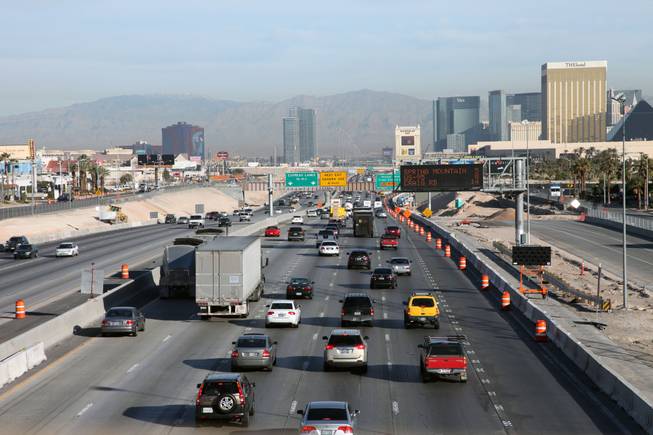
Courtesy Julie Duewel / Nevada Department of Transportation
With the proposed NFL stadium at Russell Road west of the freeway increasing their urgency, several road projects to address traffic growth on the Interstate 15 corridor over the next 20 years are in the planning stages.
Wednesday, March 29, 2017 | 2 a.m.
Now that the Raiders’ move to Las Vegas has been approved, focus is shifting to what needs to be done for the $1.9 billion, 65,000-seat domed stadium to be complete for the 2020 season.
As important as any aspect is the access to the proposed stadium site on Russell Road west of Interstate 15. The Nevada Department of Transportation is in the initial stages of road projects that have already been planned to address traffic growth on the Interstate 15 corridor over the next 20 years.
“NDOT is drafting the scope of work for environmental clearance and preliminary engineering for the I-15-Tropicana interchange reconstruction and the direct-connect HOV (high-occupancy vehicle) ramps proposed at Hacienda and Harmon,” said Rudy Malfabon, NDOT director. “A request for proposal will be issued in a few months for that scope of work.”
A 2016 study by CH2M estimated the costs for the improvements to be $899 million, but that number is subject to change.
“The estimated cost is attributed to future traffic growth on I-15 and not just the stadium,” NDOT spokesperson Tony Illia said. “The projects in the stadium report lie between Sahara Avenue and Blue Diamond Road on I-15, which is about 8 miles. Some projects are near the stadium proposed at Russell Road, but the projects aren’t because of the stadium; they are necessary to address the traffic demands anticipated on I-15 in the next 20 years or so.”
The NFL stadium sites traffic assessment report by NDOT listed the following projects that are sponsored by NDOT:
• I-15 South Phase 2B; Blue Diamond Road to Tropicana Avenue, $274 million
• I-15 HOV direct-access ramps; Blue Diamond Road to Sahara Avenue, $400 million
• I-15/I-215 direct-connect HOV ramps, $75 million
• I-15/Tropicana Interchange reconstruction, $150 million
Costs will become more defined after additional steps.
“The environmental clearance is the second step, after the planning and engineering feasibility studies that were performed in 2015 and 2016,” Malfabon said. “Once preliminary engineering is advanced enough, we can better estimate the improvement costs. These expenses include further engineering, purchasing right-of-way, relocating utilities and construction.”
Once the estimated budget for the road projects is created, NDOT will take the plan to the Regional Transportation Commission of Southern Nevada (RTC) to gain approval to add them to their construction plan, which leads to the next step.
“The projects will eventually have to be adopted into the RTC’s regional transportation improvement program, which identifies which projects are anticipated in the short-range and how they are funded,” Malfabon said. “That plan gets rolled up into the statewide plan approved by the State Transportation Board.”
Once the road projects are complete, Malfabon believes the area will be able to handle the additional 15,000-18,000 vehicles associated with game days and big events.
“The improvements were planned to address future traffic growth, but since they add capacity and improve mobility, they can make residents’ and visitors’ trips to the stadium easier,” Malfabon said.
The almost $1 billion Project Neon will also aid the stadium area. NDOT is installing an Active Traffic Management System (ATMS) which will help the agency manage traffic on I-15 better.
Malfabon said the initial stages leading up to construction are expected to take a couple of years.
“The environmental clearance and preliminary engineering contract would take about 3-6 months to procure,” he said. “We estimate it will take about two years to complete, but it depends on the solution that is selected. The environmental process, referred to as NEPA for the National Environmental Policy Act, is likely to be an Environmental Assessment (EA) which is the intermediate level of environmental clearance.”
Construction on the stadium would be underway by then, and NDOT is unsure if the road improvements will take place during that time.
“That depends on the development schedule for the stadium, but several things have to happen before the I-15 improvements can occur,” Malfabon said. Federal requirements decide what steps NDOT has to take. Although NDOT could fast-track a project, there are decisions still to be made by the State Transportation Board that may affect the timeline.
One thing that could stall potential road work on the I-15 corridor is that preliminary studies for the area were made before the stadium plan was developed, according to Malfabon.
“They address future traffic growth on I-15 but also can be used during special events,” he said. “These freeway improvements are not the stadium developer’s responsibility. Clark County, the RTC of Southern Nevada, the developer and others can determine what other improvements are needed to support the stadium traffic impacts.”
Before any work can begin on the roads, a traffic impact analysis, a parking needs analysis and a comprehensive traffic management study must be carried out.

Join the Discussion:
Check this out for a full explanation of our conversion to the LiveFyre commenting system and instructions on how to sign up for an account.
Full comments policy